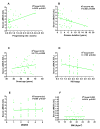Mitochondrial Creatine Kinase is Decreased in the Serum of Idiopathic Parkinson's Disease Patients
- PMID: 31165004
- PMCID: PMC6538214
- DOI: 10.14336/AD.2018.0615
Mitochondrial Creatine Kinase is Decreased in the Serum of Idiopathic Parkinson's Disease Patients
Abstract
Mitochondrial creatine kinase (MtCK) is vital in the process of mitochondrial energy metabolism, and mitochondrial dysfunction has been implicated in the pathogenesis of Parkinson's disease (PD). Therefore, we speculated that MtCK activity could be altered in the serum of PD patients. However, no studies to date have investigated this specific topic, so we sought to investigate the serum MtCK activities among a cohort of PD patients. 50 patients with PD and 30 age-matched controls were recruited for this study. Serum ubiquitous MtCK (uMtCK) and sarcomeric MtCK (sMtCK) activities were assayed using an immunoinhibition method. Correlations between serum uMtCK/sMtCK activities and clinical features/parameters were explored in the PD group. Our study revealed a significant decrease in the uMtCK activity in the PD group when compared with the control group. No significant difference was found in the serum sMtCK activity between the PD and control groups. There was a significant correlation between serum uMtCK activities and the disease progression rate, duration, and age at onset in PD patients. While no significant relationship was found between the serum uMtCK activities and the Hoehn & Yahr stage or main non-motor symptoms scale. There was a significant decrease in the uMtCK activity in the serum of PD patients, which was associated with the rate of disease progression, duration, and age at onset of disease. Therefore, uMtCK activity in serum offers a useful clue for identification of PD biomarkers.
Keywords: Parkinson’s disease; mitochondrial creatine kinase; mitochondrial dysfunction; sarcomeric mitochondrial creatine kinase; ubiquitous mitochondrial creatine kinase.
Conflict of interest statement
Declaration of Competing Interests The authors declare no competing financial, professional, or personal interests.
Figures




References
-
- Schipper HM (2004). Brain iron deposition and the free radical-mitochondrial theory of ageing. Ageing Research Reviews, 3:265-301. - PubMed
-
- Bose A, Beal MF (2016). Mitochondrial dysfunction in Parkinson’s disease. J Neurochem, 139 Suppl 1:216-231. - PubMed
-
- Abou-Sleiman PM, Muqit MM, Wood NW (2006). Expanding insights of mitochondrial dysfunction in Parkinson’s disease. Nat Rev Neurosci, 7:207-219. - PubMed
LinkOut - more resources
Full Text Sources
